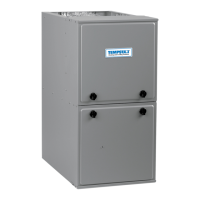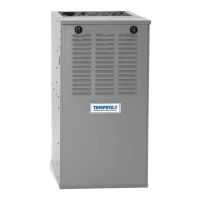N95ESN: Installation, Start-up, Operating and Service and Maintenance Instructions
Manufacturer reserves the right to change, at any time, specifications and designs without notice and without obligations.
29
Vent systems must be composed of pipe, fittings, cements, and primers
listed to ULC S636. M&G DuraVentRPolyProR or Centrotherm
InnoflueR polypropylene venting systems are ULC S636 listed.
NOTE: When using polypropylene venting systems, all venting
materials used, including the vent terminations must be from the same
manufacturer.
Venting Systems
Direct Vent / 2-Pipe System
In a direct-vent (2-pipe) system, all air for combustion is taken directly
from outdoor atmosphere, and all flue products are discharged to outdoor
atmosphere. Combustion-air and vent pipes must terminate together in
the same atmospheric pressure zone, either through the roof (preferred)
or a sidewall. See Fig. 41 for references to clearances required by
National code authorities.
Ventilated Combustion Air Systems
In a ventilated combustion air option, the vent terminates and discharges
the flue products directly to the outdoors similar to a direct vent system.
See Fig. 42 for references to clearances required by National code
authorities.
All air for combustion is piped directly to the furnace from a space that is
well ventilated with outdoor air (such as an attic or crawl space) and the
space is well isolated from the living space or garage. Combustion air
requirements for this option are the same as the requirements for
providing outside air for combustion for a single pipe vent system. Refer
to the “Air For Combustion and Ventilation” Section.
Non-Direct Vent (1-pipe) System
In a non direct-vent (1-pipe) system, all air for combustion is taken from
the area adjacent to furnace, and all flue products are discharged to
outdoor atmosphere. Air for combustion must be supplied as described
in the Air For Combustion and Ventilation Section. Do not use an
abandoned chimney to supply outside air to the furnace. See Fig. 42 for
references to vent clearances required by National code authorities.
NOTICE
!
OPTIONAL CONFIGURATION FOR COMBUSTION AIR INLET
PIPE
In applications where there is a risk of excessive moisture entering the
combustion air inlet pipe, a moisture trap may be added to the inlet pipe
to help prevent moisture from entering the furnace from the combustion
air inlet pipe. See Fig. 50.
When sizing venting systems, the equivalent length of the optional inlet
pipe moisture trap must be taken into account.

